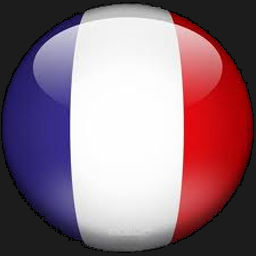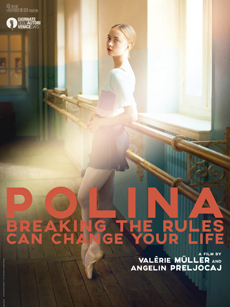DIRECTOR’S NOTE
The project came about through the meeting with Bastien Vives at the Comic Book Festival in Aix-en-Provence in 2010. We immediately appreciated the cartoonist’s unique personality and his drawing, which is both sober and expressive.
Bastien subsequently published Polina, the story of a young dancer trained at the classical school of Russian ballet and who, as an adult, experiences contemporary creation across Europe. In this story, he included choreographic elements from Angelin’s Snow White, as well as elements from the daily lives of dancers. We found this immersion into the world of dance, via the relationship between a teacher-initiator and his student, fascinating.
It had all the elements to build the career of an artist, of whom Isadora Duncan or Pina Bausch could be examples. The portrait of a free, sensitive and powerful woman.
In the screenplay adaptation, the work mainly involved bringing the graphic universe of Bastien Vives to life. We therefore maintained this relationship with reality, the dancer’s daily work, and added the character’s social environment. We specified the professional and emotional issues of each character in a world that is sometimes exactly true to reality, while sometimes allowing ourselves some deviations that are always close to reality.
Consequently, in a post-Soviet Russia in crisis, where the Iron Curtain collapses on a rapidly changing Europe, Polina’s path takes her from pillar to post from Moscow to Antwerp, through Berlin and Aix-en-Provence, and reshapes the emotional territory of her artistic approach. Similarly, her relationship with the two paternal figures of her childhood, Anton, her biological father, and Bojinski, her ballet teacher, whose respective personalities are completely opposite, gives form to her psychological journey throughout the story.
Polina’s path is as much a physical and emotional adventure as an artistic adventure. She discovers the possibilities of her body and pushes its limits through high-level classical dance, then questions all this investment when she discovers contemporary dance. The duo that she creates after this long career as a dancer contains this questioning of the body. It is full of both her successes and her failures.
The choreography draws on Polina’s technical capacities, inherited from the classic discipline, but also her discoveries, her wanderings around contemporary dance. And it is, of course, a choreography that evokes the founding vision of Polina. Indeed, as a child, Polina’s taste for dance comes about through this vision of a couple dancing. When, as an adult, Karl asks her: “The first time you wanted to dance, what did you want to express?”, she replies: “Two bodies that seek to come together to fight the initial solitude.”
This will indeed be what her choreographic creation will be about. Bringing together two bodies that fight the initial solitude. It is a duo of love, of desire, where sensuality expresses this desire for the other’s body in order to completely eradicate the incompleteness of the being. The gestures will be contemporary, but will express this dramaturgy of bodies seeking to become one.
The aim is, of course, to write this duo in its choreographic form, but also in its relation to the camera, as it will be created for the film. It involves giving life to the bodies as if they were faces, so that they express a human adventure.
One of the challenges for the film is still to find the actress who can literally dance the role (without a stand-in). As the physical presence of a dancer is so specific, we feel it is essential to capture this specificity on screen. In addition to young Polina when she is 8, we think it is important for just one actress to play Polina as a teenager, Polina as a young woman, and Polina as an accomplished woman in her late thirties. We have started a casting process in Russia, but also at international level, as we are aware that the search for this dancer/actress is a real challenge.
The sequences in Russia will be filmed in Russian and we have already selected two actors, during an initial meeting in Moscow, to play Natalia, Polina’s mother, and Bojinski. They are, respectively, Xenia Kutepova and Sergeï Garmash, who are both highly respected actors in Russia, with a strong dramatic and emotional presence.
The rest of the casting will be French-speaking, even for the Antwerp part of the film.
In this “four-handed” film, we have agreed to divide up the work, while always remaining open to one another’s remarks at each stage of the making of the film. Consequently, Valérie is working more on writing the screenplay, while Angelin will closely follow the editing of the film. We have also decided that we will work together on the shot-by-shot editing of the film, and that on the set, Angelin will deal with the dance part and preparing the frames with the operator, while Valérie will handle more the actor direction.
But the interest of two people making the film will be to always remain responsive to one another in order to benefit from our respective experiences and sensitivities.
In terms of the image work, the successive sequences alternate raw visions of reality and an aesthetic framing of Polina’s environment.
More specifically, the work sequences in the studio will be close to the actors/dancers, filmed with the camera on the shoulders or with a steadicam. Two cameras will also probably be installed to capture the working atmosphere in the dance studios with a “fly-on-the-wall” staging.
In resonance, the scenes of daily life outside the workplaces, in the suburbs of Moscow or in the surrounding nature, will be filmed with wide shots in order to bring to life the sets to which we wish to give both a monumental and sensory importance.
The photographic work of the Russian Alexander Gronsky, which we particularly appreciate, strongly conveys our aesthetic vision of the film. We have been to check out locations in the suburb of Moscow, in order to identify places where we could recreate both the concrete austerity of Moscow’s residential blocks, and introduce the poetry that the little Polina brings to it.
It involves transcending the austere and poor environment of the young dancer. Polina lives in difficult conditions by Western standards, but she sees all the magic of childhood there. When she goes hunting with her father so that there is “something to put in the saucepan”, this event becomes a field of adventure and unexpected experiences for her.
Our meeting with the director of photography, Georges Lechaptois, confirmed this desire to give life to the natural settings by capturing their dramatic and aesthetic beauty.
In Moscow, Aix-en-Provence and Antwerp alike, the dance studio always becomes a place that is very demanding, and where there is self-questioning or even suffering.
In opposition, the outside stimulates the imagination of the young dancer.
Consequently, the rehearsal studio that she decides to rent in Antwerp to produce her own choreography continues to be this place of concentration and work that she has known since her childhood, but what will happen there will be the source of her dazzling career in the world of choreography.
Valérie Muller & Angelin Preljocaj
 Print
Print




























